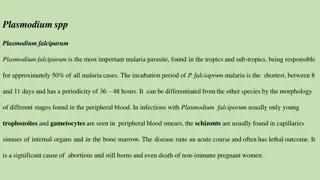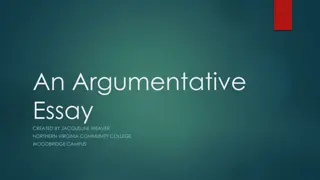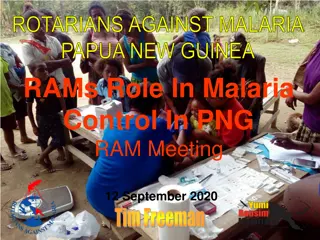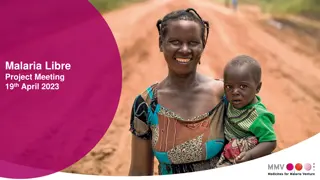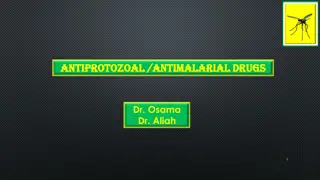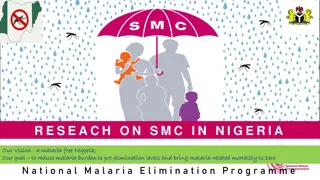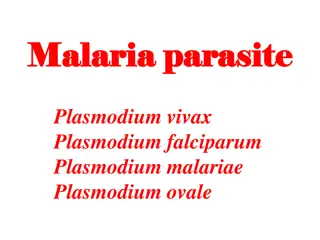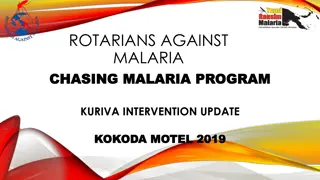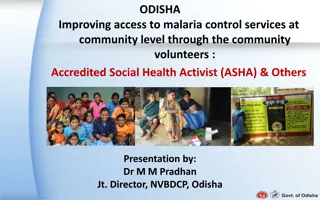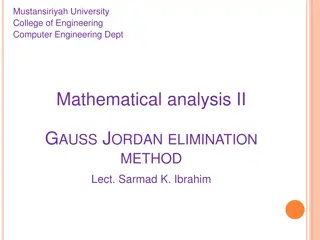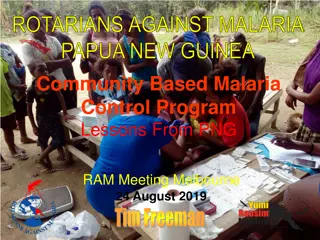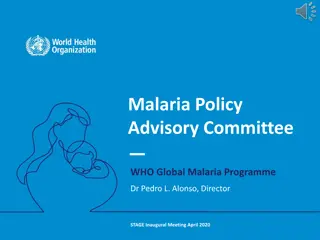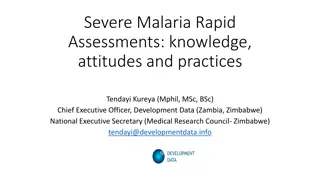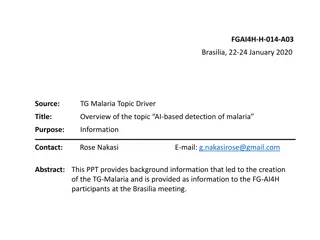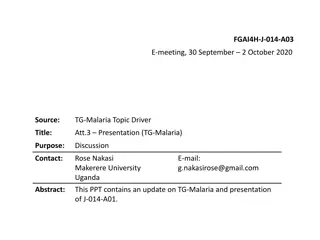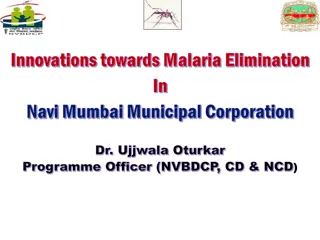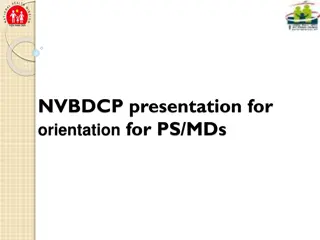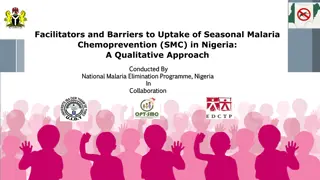Economic Perspectives on Malaria Control and Elimination
Analyzing malaria control and elimination from an economic standpoint is crucial for understanding the long-term health outcomes, cost savings, operational strategies, funding gaps, and wider economic consequences of the disease. By examining the correlation between malaria and poverty, exploring funding shortfalls, and assessing the global burden of vivax malaria, economists like Angela Devine shed light on the economic and social impact of malaria and the importance of investment in control measures for sustainable economic growth.
Download Presentation

Please find below an Image/Link to download the presentation.
The content on the website is provided AS IS for your information and personal use only. It may not be sold, licensed, or shared on other websites without obtaining consent from the author.If you encounter any issues during the download, it is possible that the publisher has removed the file from their server.
You are allowed to download the files provided on this website for personal or commercial use, subject to the condition that they are used lawfully. All files are the property of their respective owners.
The content on the website is provided AS IS for your information and personal use only. It may not be sold, licensed, or shared on other websites without obtaining consent from the author.
E N D
Presentation Transcript
How to think about malaria control and elimination like a health economist Angela Devine Rotarians Against Malaria Conference 22 October 2021 @devinefy
Seeing science through an economic and operational lens 1. What will be the impact? (e.g., long-term health outcomes & cost savings)
Seeing science through an economic and operational lens 1. What will be the impact? (e.g., long-term health outcomes & cost savings) 2. How will it work (in the field)?
Seeing science through an economic and operational lens 1. What will be the impact? (e.g., long-term health outcomes & cost savings) 2. How will it work (in the field)? 3. How much will it cost? (And who will pay for it?) Spatial emanators
Seeing science through an economic and operational lens 1. What will be the impact? (e.g., long-term health outcomes & cost savings) 2. How will it work (in the field)? 3. How much will it cost? (And who will pay for it?) 4. What are the wider economic consequences of disease?
The economic and social burden of malaria Review by Sachs & Malaney (2002) Nature Argue that the correlation between malaria and poverty runs both ways Poverty promotes malaria transmission Malaria causes poverty by impeding economic growth
Funding for malaria treatment & control Malaria funding shortfall 6000 Millions 5000 4000 Suggested that malaria control would be a valuable way to increase economic growth But point to huge funding shortfalls Still have a shortfall today But we have a higher % of the funding needed 3000 2000 1000 0 2007 (Sachs) 2019 (WMR) Current funding Funding needed
Global burden of vivax malaria = US$359m Only includes treatment costs & foregone productivity in 2017 Devine 2021 Plos Med
Vivax malaria global cost scenarios 400000000 350000000 300000000 250000000 200000000 150000000 100000000 50000000 0 Current Supervised radical cure Unsupervised radical cure Supervised radical cure (1 visit) Healthcare provider costs Direct household costs Indirect household costs Devine 2021 Plos Med
Types of Economic Evaluation Type of analysis Cost minimisation Cost consequence Cost measure Money Money Consequence measure Identical outcomes List of separate outcomes (no comparable valuation) Money Results reported Lower cost Summary table of costs and consequences Cost benefit Money Maximize the difference between benefits and costs Cost per unit (ie cost per infection averted) Cost per QALY gained or DALY averted Cost effectiveness Money Natural units (ie infections averted) Multiple effects valued as a common unit (ie DALY or QALY) Cost utility Money
Incremental cost-effectiveness ratios Total costs (B) - Total costs (A) ICER = Outcomes (B) - Outcomes (A) Incremental Costs ICER = Incremental Outcomes ICER = Cost per QALY gained ICER = Cost per DALY averted ICER = Cost per infection averted
New frontiers for vivax malaria CEAs Single-dose tafenoquine for radical cure Quantitative G6PD testing Simple interventions to improve effectiveness of primaquine Short course primaquine regimens Day 3 review to improve adherence & prevent haemolytic events Directly observed therapy for primaquine Patient, provider & community education SD Biosensor
Pv global burden scenario analysis 400000000 350000000 300000000 250000000 200000000 150000000 100000000 50000000 0 Current Supervised radical cure Unsupervised radical cure Supervised radical cure (1 visit) Healthcare provider costs Direct household costs Indirect household costs Devine 2021 Plos Med
Question for malaria control programs Do we invest in developing and implementing new tools? Or do we focus on making sure that things like bednets and effective treatment are operating well? Funding something new requires a disinvestment is something old unless the budget is increased
WMR 2020 Paulden 2016 Malaria funding comes from a range of sources But do they all have the same priorities? Budget for malaria vs budget for the whole healthcare system Funding challenges
Getting the intervention mix right Malaria control requires packages of complementary measures, but economic evaluations consider single interventions (Goodman 1999 Health Policy Plan) Economic evaluation using transmission models Interventions differ in impact on malaria species Multi-species malaria models to incorporate impact on both Pf and Pv Heterogeneity in malaria epidemiology Geographic resource allocation by district rather than country (Drake 2017Appl Health Econ Health Policy) Online interactive models give decision makers a chance to see the impact of parameters on outcomes (Devine 2017 Plos NTDs, Devine 2021 Plos Med) Multi-species malaria model (in preparation)
Online interactive models Estimates provider and household costs of national policies for the treatment of vivax malaria management Radical cure scenario: 14-day supervised PQ treatment provided to all who are eligible and test G6PD normal Global cost app Devine 2021 Plos Med
Elimination challenges Countries are unlikely to achieve elimination without regional cooperation As cases drop: The cost per case increases (economies of scale) Community health workers will become less effective (economies of scope) We need to replace short-term thinking with long-term vision for malaria elimination Investment case (tourism, workforce productivity)
Start thinking like a health economist 1. What will be the impact? (e.g., long-term health outcomes & cost savings) How is what you re doing now going to impact malaria in the future? 2. How will it work (in the field)? Is it practical for a setting without electricity or A/C? Will people be willing to travel for this treatment? 3. How much will it cost? (And who will pay for it?) Involve a health economist early to collect appropriate data alongside clinical trials 4. What are the wider economic consequences of the disease? Greater awareness of the economic burden of malaria to bring context as to why what you re working on is important
Thank you! Menzies MORU Telethon Kids + Curtin Ric N. Price Yoel Lubell Pete Gething Kamala Thriemer Burnet Institute Institute for Disease Modelling UniMelb Win Han Oo Katherine Battle Julie A. Simpson Freya Fowkes Niamh Meagher Paul Agius FIND Saber Dini Julia Cutts Rosalind E. Howes Leanne Robinson




